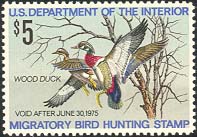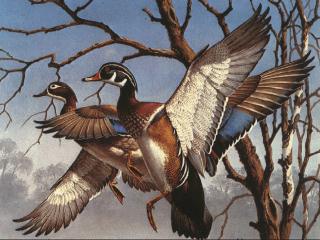

Back to RW41 Back to the Federal Index Home
A LITTLE HISTORY ON THE 41TH (1974-75) DUCK STAMP ARTIST


Mr. Maass started his career without the help of any formal art education, but he was gifted with incredible talent. He was aided by wonderful friends and driven by an exceptionally strong will that helped him become one of the top wildlife artists today. When the subject of wildlife art is discussed, Mr. Maass' paintings often become part of the conversation.
After his graduation from high school, he landed his first job, working for a leading manufacturer of high school and college jewelry. His first work was in the tool and die department. Within a year and a half, he was transferred to the art department and ultimately became are director. Another excellent wildlife artist, Stu Ferreira, worked in the department. He helped Mr. Maass improve his technique and gave him the encou4ragement he needed to continue painting.
When he finished his two-year hitch in the Marines, he headed straight back to his home state to set up housekeeping.
Mr. Maass did reap some benefits from his time in California, however. It was there that he met and became friends with a fine wildlife artist, David Hagerbaumer. Mr. Hagerbaumer's persistent coaching and constructive criticism were important in helping Mr. Maass perfect some of the fine points of wildlife art.
In addition to Mr. Hagerbaumer, Mr. Maass has always admired Owen Gromme; designer of the twelfth Duck Stamp. Mr. Gromme's knowledge of his environment and of the anatomy of his subjects was astounding. When Mr. Maass won the Duck Stamp contest, Mr. Gromme was creating some of his finest works at age 78.
In addition to his win in the Duck Stamp contest, Mr. Maass was selected by Ducks Unlimited as Artist of the Year for 1974. He feels that this was the greatest honor that he ever received because the award comes from the vote of more than 700 Ducks Unlimited officers, conservationists, and hunters who know the birds and their habitats well. Unlike many competitions, it is not a contest in which one particular work is chosen as the best. It is an all-encompassing award for outstanding ability in the field of wildlife art.
--------------------THE ART--------------------
Wood Ducks was painted in full color oil paints. The print is by photolithography four-color process in specially compounded lightfast inks on Warrens Lusto Dull Saxony Finish paper. The edition was signed in pencil but not numbered. 100 artist proofs were signed in pencil and numbered. The image size of the print is 6-1/2" x 9".
--------------------THE STAMP--------------------
Wood Ducks…Engraved by the Federal Bureau of Engraving from the original artwork. Printed in yellow, red, grey, blue, light blue, brown, and black ink. The stamp sold for five dollars. Postal records show 2,190,268 stamps sold. First day of sale was July 1, 1974.
Most of the information contained above is from the book Federal Duck Stamp Story, Fifty Years of Excellence, by Laurence F. Jonson; Alexander & Co. It is used here with permission from the author. For more information on this book, please click here.